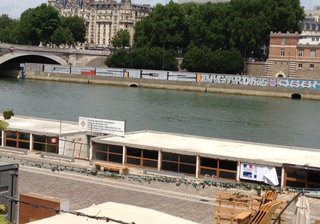Walking along the Seine here in Paris might evoke romance and architectural overload, but I find myself constantly drawn to looking at what's floating on the river rather than what's around it. What impresses me is the variety and creative uses that the French have developed for barges.
In addition to being a beautiful and historic river, the Seine continues to be an important commercial waterway. It's not unusual to see workboats sharing the river with the crowded and loud tourist boats — also called barges although not in the way you'd think — barking out explanations in four different languages as they pass by the sights of the city.
Barges here have connotations far beyond workboats. This being Paris, people here live on them, eat on them, work on them, drink on them, sleep on them and dance on them. There are floating cafe barges, restaurant barges, nightclubs, and pool barges. And there's a plan before the Mayor of Paris to create four floating farm barges that would grow vegetables and become a much-welcoming plot of green in the city center.
The majority of barges don't ever move, as they are moored to the waterfront. Some are new construction and others are renovated workboats.
The glass and steel Josephine Baker barge, named after the American jazz performer and civil rights activist who was a sensation in Paris in the 1920s, is a municipal swimming pool. It is outfitted with lap and wading pools, a gym, sundeck, and jacuzzi-sauna-steam room.
Located along one of Paris' many canals, La Péniche Cinéma (Barge Movie Theater) screens films and can be rented for conferences and festivals.
There are also about 1,000 barge/houseboats along the Seine that are converted workboats or built to be houseboats. They are flat-bottomed vessels specially designed for narrow canals or rivers. Many are available in season for vacation rentals, offering a unique way to be in the middle of Paris, on the river, but not necessarily living as a bargeman. Some of these "barges" boast sundecks, flat-screen TVs, wifi, top flight kitchens and luxurious baths and bedrooms. The price? About $4,800 a week. But for that you get a view of the Eiffel Tower!
The Louise-Catherine. Photo: Pamela Glass.One of my favorites is a scruffy old vessel moored in the 13th arrondissement in the modernized Port of Austerlitz along the Seine's left bank. The Louise-Catherine sits idly and lonely, and on the day I walked by, there was a single workman onboard hammering and welding, as the boat's renovation project grinds into a third year.
Built in 1915 of concrete, the barge was used to haul coal from Rouen in Normandy to Paris. In 1929, a rich American-born French princess bought the retired vessel and contracted the famous Franco-Swiss architect Le Corbusier to convert it into a shelter for the homeless. He changed up the windows, added an outdoor terrace and an indoor cafeteria, and made space for 160 beds in three dormitory rooms. The shelter was run by the Salvation Army and became one of the largest Salvation Army centers in France until it was sold in 1994. In 2008, the barge was classified as an historic monument. Plans are now afoot to convert it into a cultural center concentrating on art and architecture.
Good to know that you can indeed teach an old barge new tricks.




